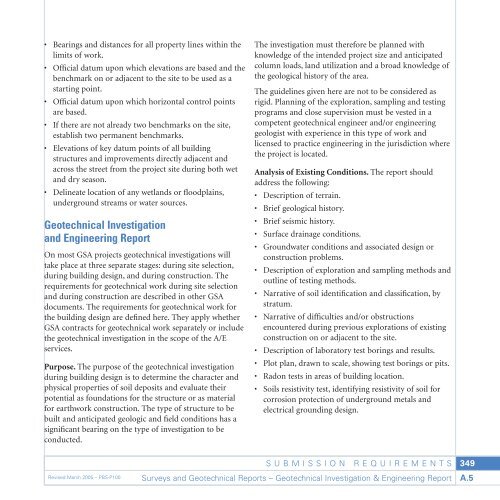Appendix - GSA
Appendix - GSA
Appendix - GSA
You also want an ePaper? Increase the reach of your titles
YUMPU automatically turns print PDFs into web optimized ePapers that Google loves.
• Bearings and distances for all property lines within the<br />
limits of work.<br />
• Official datum upon which elevations are based and the<br />
benchmark on or adjacent to the site to be used as a<br />
starting point.<br />
• Official datum upon which horizontal control points<br />
are based.<br />
• If there are not already two benchmarks on the site,<br />
establish two permanent benchmarks.<br />
• Elevations of key datum points of all building<br />
structures and improvements directly adjacent and<br />
across the street from the project site during both wet<br />
and dry season.<br />
• Delineate location of any wetlands or floodplains,<br />
underground streams or water sources.<br />
Geotechnical Investigation<br />
and Engineering Report<br />
On most <strong>GSA</strong> projects geotechnical investigations will<br />
take place at three separate stages: during site selection,<br />
during building design, and during construction. The<br />
requirements for geotechnical work during site selection<br />
and during construction are described in other <strong>GSA</strong><br />
documents. The requirements for geotechnical work for<br />
the building design are defined here. They apply whether<br />
<strong>GSA</strong> contracts for geotechnical work separately or include<br />
the geotechnical investigation in the scope of the A/E<br />
services.<br />
Purpose. The purpose of the geotechnical investigation<br />
during building design is to determine the character and<br />
physical properties of soil deposits and evaluate their<br />
potential as foundations for the structure or as material<br />
for earthwork construction. The type of structure to be<br />
built and anticipated geologic and field conditions has a<br />
significant bearing on the type of investigation to be<br />
conducted.<br />
The investigation must therefore be planned with<br />
knowledge of the intended project size and anticipated<br />
column loads, land utilization and a broad knowledge of<br />
the geological history of the area.<br />
The guidelines given here are not to be considered as<br />
rigid. Planning of the exploration, sampling and testing<br />
programs and close supervision must be vested in a<br />
competent geotechnical engineer and/or engineering<br />
geologist with experience in this type of work and<br />
licensed to practice engineering in the jurisdiction where<br />
the project is located.<br />
Analysis of Existing Conditions. The report should<br />
address the following:<br />
• Description of terrain.<br />
• Brief geological history.<br />
• Brief seismic history.<br />
• Surface drainage conditions.<br />
• Groundwater conditions and associated design or<br />
construction problems.<br />
• Description of exploration and sampling methods and<br />
outline of testing methods.<br />
• Narrative of soil identification and classification, by<br />
stratum.<br />
• Narrative of difficulties and/or obstructions<br />
encountered during previous explorations of existing<br />
construction on or adjacent to the site.<br />
• Description of laboratory test borings and results.<br />
• Plot plan, drawn to scale, showing test borings or pits.<br />
• Radon tests in areas of building location.<br />
• Soils resistivity test, identifying resistivity of soil for<br />
corrosion protection of underground metals and<br />
electrical grounding design.<br />
Revised March 2005 – PBS-P100<br />
SUBMISSION REQUIREMENTS<br />
Surveys and Geotechnical Reports – Geotechnical Investigation & Engineering Report<br />
349<br />
A.5
















